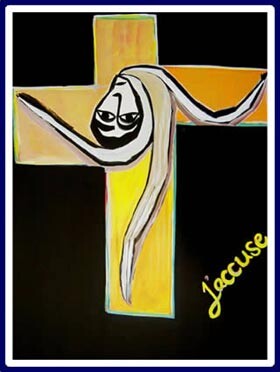The Daily Star 18 February 2004

“Return 1,” Zahi Khamis
WASHINGTON: The figures in Zahi Khamis’ paintings have twisted necks, their almond-shaped eyes peering upside down, tragically staring out at a land they will never know. The visual experience of the exhibit Of Exile and Return replicates the emotional experience of pain, love, longing and fear that Palestinians feel as they struggle to define themselves.
Khamis, a Palestinian who has lived in the US for 22 years, sees his paintings as a commentary not only on Palestinians exiled from their homeland, but on humanity as a whole, for whom home plays a central role in defining the self.
“The exile of the Palestinian people is a collective experience,” said Khamis, whose exhibit opened at the Jerusalem Fund at the Palestine Center in Washington on Friday.

“J’accuse,” Zahi Khamis
“I’ve lived half my life outside of Palestine,” said Khamis in an interview with The Daily Star. “I have never been to the Arab world because I couldn’t, still can’t, because I’m what they call an Arab-Israeli.”
Born in 1959 in a small village outside of Nazareth, Khamis emigrated to Europe and then the US in his early 20s.
As he views it, no peace plan that fails to allow refugees to return to Palestine would be adequate or acceptable.
“That would be … absolute denial to Palestinian history, to the whole human story,” he said. “Return is not just returning to homeland, it is focused on refugee return. We need to return not only to the place where we are born but to our self, (our) values, to international law.”
Before becoming an artist, Khamis wrote poetry and kept journals in which he would sketch in charcoal the figures that now emerge on canvas.
“I always felt I wanted to speak, and language failed me,” he said.
As he got older he discovered that expressing himself became more important. His use of stark, two dimensional shapes in bold primary colors evoke raw emotions of pain, suffering and hope reflected in the huge eyes that become the gravitational point of each painting. The eyes of the central curvilinear figure induce a sense of loss, reflecting the childlike longing of a people yearning for home. Contorted lines denote a sense of pain that, juxtaposed with the childish shapes, also portrays hope.
“In Palestinian children, the images of them, the one thing that stays with you is their eyes,” said Khamis. “Every song has the eyes; there is much tradition built around eyes. And there is the idea of the witness, and if the eyes are open there is life, too.”
“Anaat,” Zahi Khamis

“Anger,” Zahi Khamis
In Anaat, a goddess-like figure embraces three small, bent figures. Inspired by the poetry of Darwish, Khamis recounted the story of the Canaanite goddess of peace and war that inspired the painting.
Khamis said there is more optimism than despair in the people he painted, though he says at times there was a sense of hopelessness in the figures, whose black, twig-like arms and legs lack hands and feet.
“It’s more symbolism than real human shapes,” he said. “When you look at these figures, such as in Return, you see these twisted bodies, they don’t really look like human bodies … but yet they are very close.”
Hands are absent in all the paintings on exhibit, so the focus remains on the eyes and the colors, and how the colors and the figures interact with their environment. Having noticed the absence of extremities in his paintings, Khamis said he had begun experimenting with hands.
His more recent paintings have a narrative authored by the tragedy of the second intifada, underscoring the rejection and denial of the Palestinian experience and their rights as a part of a broader human experience.

“Return 4,” Zahi Khamis
“Going toward the West, as entering exile, you lose all complexity,” he said. “You lose who you are … your background doesn’t matter anymore, it’s not recognized.”
The influence of geometry and math is most apparent in his 2000 works, a time when he taught geometry and Islamic architecture in San Diego.
Khamis earned a degree in Mathematics at San Diego State University and teaches math to junior high school students, although he said he wishes he could teach them art.
The exhibition runs through March 30th. Zahi Khamis’ work can be also be viewed at PalestinianArt.com. This article was originally published under a different headline by The Daily Star.

